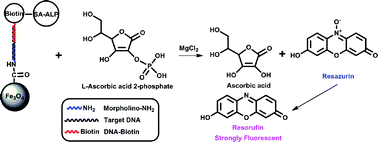Highly sensitive detection of sequence-specific DNA with morpholino-functionalized magnetic microspheres
Abstract
In this work, a highly effective biosensor supported on morpholino-functionalized magnetic microspheres was investigated for the sequence-specific detection of DNA. Briefly, morpholino was first modified on the surface of magnetic microspheres through amido bonds, and then hybridized with target DNA in the ensuing step. Biotin-labeled signal probe DNA was designed to hybridize with the DNA nearby the 5′ end of sequence, and the biotin was used to bind with streptavidin-alkaline phosphatase (SA-ALP). L-Ascorbic acid-2-phosphate (AAP) was hydrolyzed by ALP to generate L-ascorbic acid, which could reduce resazurin to resorufin, resulting in a turn-on fluorescence signal. UV-vis absorbance spectroscopy was applied to prove the conjugation of ALP with signal probe DNA. Under optimal conditions, this biosensor displayed a good linear relationship between the fluorescence intensity and logarithm of single-stranded DNA concentrations in the range of 0.1 pM to 0.1 nM with a low detection limit of 9.32 fM. Moreover, fully complementary versus single-base mismatched, three-base mismatched and non-complementary DNA could be effectively distinguished. In addition, this novel approach rendered satisfactory analytical results for the determination of DNA in serum, thus exhibiting practical significance. These results demonstrated that this assay method displays excellent sensitivity and specificity for DNA detection and has great potential for practical applications.


 Please wait while we load your content...
Please wait while we load your content...